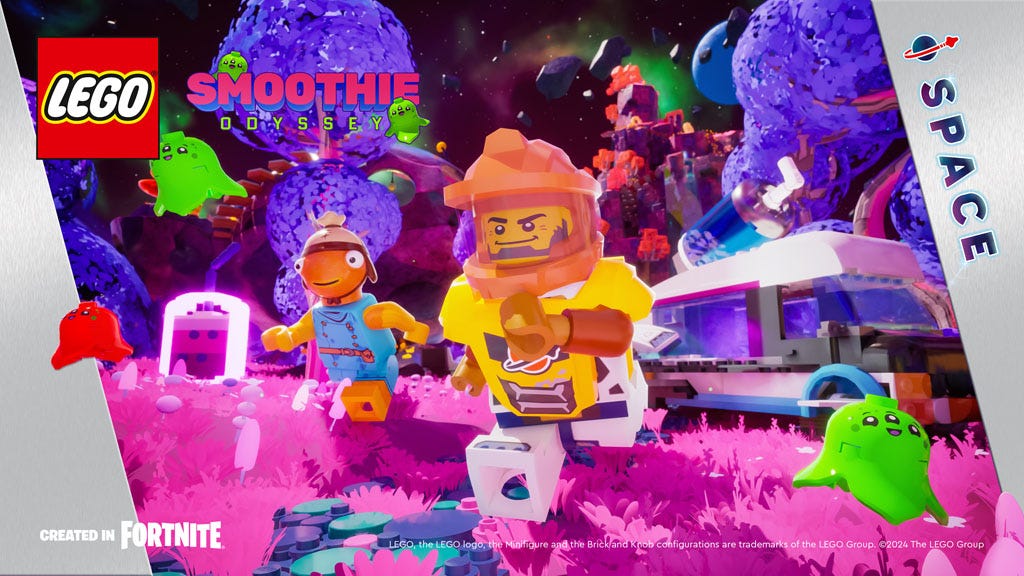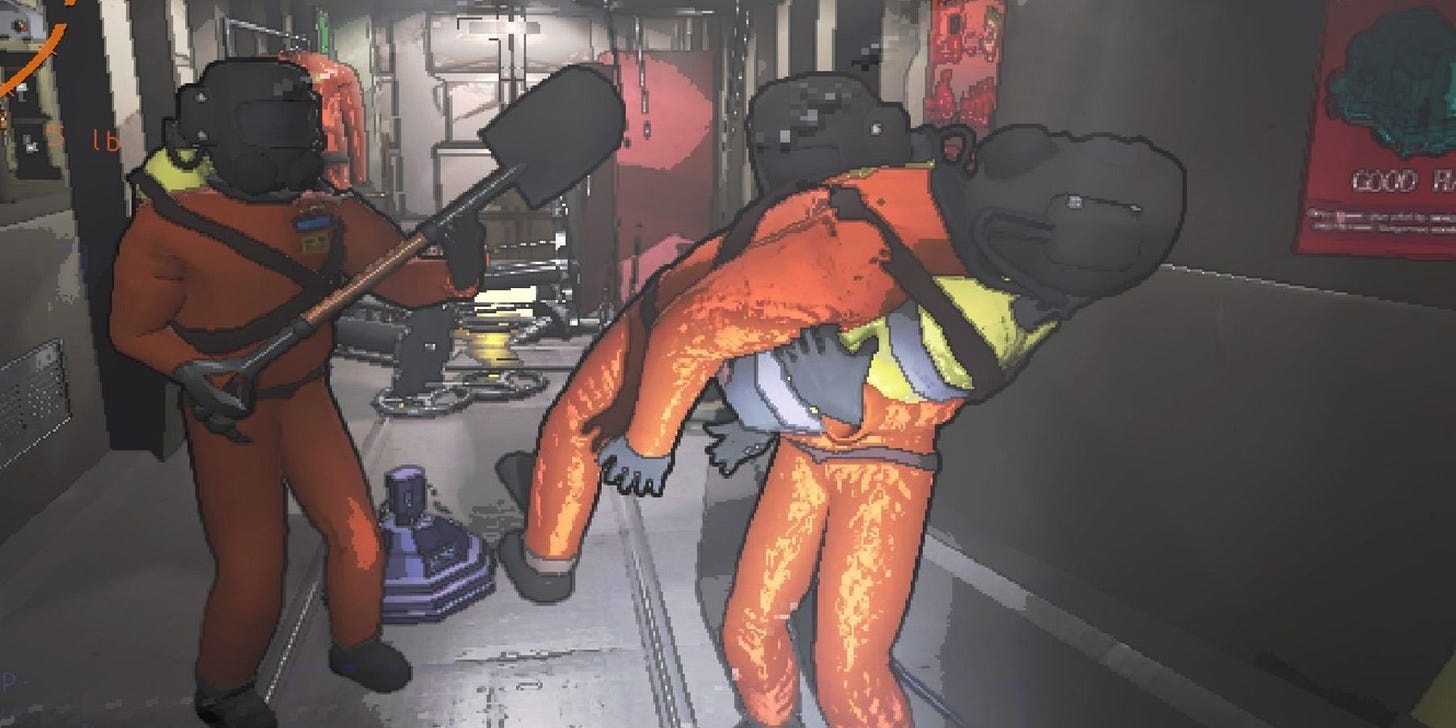LEGO's hype for Fortnite, proximity chat, and lumberjacks: This Week in UGC
Welcome back to This Week in UGC, where we cover all the important details you need to know about lumberjacks. Don’t worry, we’ll explain.
Before we get to that, we have a similarly critical topic to cover: smoothies.
LEGO <3 Fortnite - What’s behind the hype?
We mentioned at the end of last week’s newsletter that gamesindustry.biz (whose editorial staff was disappointingly just hit with “redundancies”) published an excellent article on the long-term partnership between LEGO and Epic. LEGO, as a brand, has enjoyed a remarkable expansion over the last decade or so, with a successful push into adult sets, huge collabs and huge price tags, and more overlap with gaming brands. Of course, LEGO and video games are no strangers, with countless popular entries released over the last twenty years. The LEGO universe expanded once again this past Tuesday with the release of LEGO Smoothie Odyssey, the latest space-themed Fortnite island from the company.
The article has a few excellent insights from LEGO’s Kari Vinther Nielsen that suggests why Fortnite makes sense both for their brand and business. Creation, is of course, core to the LEGO experience, so a platform that affords rapid experimentation and deployment of new experiences is somewhat analogous to dumping out a bin of LEGO bricks and letting the imagination run wild. For LEGO’s own developers, this means low-cost iteration of ideas that can be tested among an existing engaged audience, while Fortnite’s own creator community can, as Vinther Nielsen says, “do things that we hadn't thought of ourselves.” LEGO benefits from additional brand touchpoints and the ability to learn and iterate based on successful community creations - just as they do with their physical products.
What’s also important to recognize is that there’s no evidence that this is coming at the expense of traditional console and PC games; there’s a rumor that LEGO and PlayStation are partnering on a game with the Horizon IP. The wisdom of this approach is in understanding the varied possibilities of gaming platforms and how to reach their audiences with appropriate, high-quality content. In an ideal scenario, successes in content on UEFN can feed into console and PC gaming, or even physical brick sets. At the very least, LEGO can continue extending their brand among an engaged audience far more frequently than would be possible with a traditional development and publishing model.
UEFN proximity chat…when?
If you aren’t already familiar with the UEFN Roadmap, you should be! You’ll find a variety of tech and tools that the team at Epic is working on, including proximity chat, which is currently earmarked for Q2 2024. That’s now!
This feature has been rumored and discussed in the broader context of Fortnite for some time, both positively and vehemently negatively. Within UEFN, this will be an incredibly powerful tool for the development of experiences that have so far been impossible within Fortnite.
Fortnite is, of course, highly dominated by competitive experiences, and proximity chat has the ability to evolve those experiences in the same way it has for games like fellow battle royale Call of Duty: Warzone or extraction shooters like Hunt: Showdown. Creators may be able to combine proximity chat with new platform functionality like Verse persistence to create experiences similar to extraction shooters or competitive shooters with progressive character-based unlocks.
If you look at some of the most popular and exciting projects on Steam in recent months, including Lethal Company, Content Warning, and Abiotic Factor, you can imagine what they all have in common: excellent implementations of proximity chat in a cooperative gameplay context. In these games, communication challenges and how to overcome them become a core gameplay feature, enhancing every other gameplay system present and leading to surprising, and often hilarious, moments.
As always, creators who mash up familiar gameplay styles (across both Fortnite and traditional PC and console gaming) with new platform functionality will push the boundaries of what’s possible within Fortnite. We expect to see creators rapidly adopt proximity chat and experiment with design elements that we haven’t seen on Fortnite to date.
Why thousands are playing a game about lumberjacks
Browsing Fortnite’s Discover page, you’ll find some familiar themes: core experiences from Epic, competitive shooters, tycoon games, and a game about chopping down trees. Wait, what?
Lumberjack Heroes landed on Fortnite back in March and has managed to retain thousands of concurrent players - all despite the gameplay being based around chopping trees and gathering wood…in service of chopping more trees and gathering more wood. And as of this writing, a new update has pushed it above 4,000 active players right to the top of the Most Engaging list. So, what’s going on here?
The foundational design of Lumberjack Heroes falls into the incremental or idle genre (think Cookie Clicker) where the player’s primary objective is to make the numbers go up. While these games have relatively basic gameplay often based around clicking and menu interactions, the underlying systems are anything but, with expansive upgrade systems that can see the player gathering a single resource one minute and 1e9 resources the next. When the numbers go up, they go up a lot.
Lumberjack Heroes expertly builds these systems into the existing foundation of UEFN, with the third-person player character navigating small, confined environments filled with trees and chopping them to gather wood (there’s your clicking mechanic). From there, NPCs and character devices provide access to various upgrade systems, and Verse persistence carries your character progression across sessions. Even this basic design may have led to success, but Lumberjack Heroes extends the options further with a pet and rarity system, light combat scenarios that support multiplayer, and an idle area that allows players to gather resources even without actively playing.
On top of all of this, the concept and design are extensible to a nearly infinite degree. New zones, new bosses, and bigger numbers can ensure a long life and consistent playerbase for the game. While there’s always the risk that players could get bored with the game, those who get hooked always have something to come back for. It’s all extremely smart, and it even enjoys the benefit of offering something different from every other incremental game by borrowing elements from the core Fortnite experience. It’s one of the best examples yet of making something unique in UEFN.
Until next time, we’ll leave you with a bit of intrigue: Epic announced earlier this week that we’ll see v30.00 on Friday morning (proximity chat, perhaps??). We’ll surely be here next week to cover all the new UEFN news and talk about Disney’s partnership with Epic affording creators “the opportunity to create their own wholly unique Disney-themed gaming experiences.”







